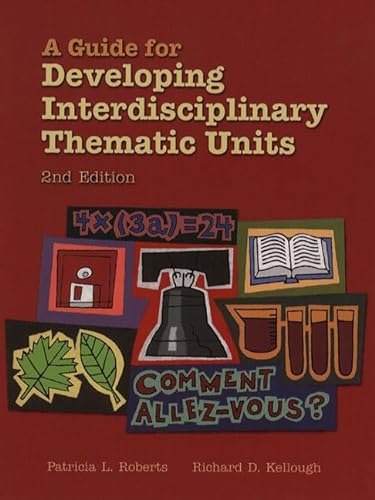Items related to A Guide for Developing Interdisciplinary Thematic Units...

Synopsis
This book thoroughly demonstrates the step-by-step process involved in developing an interdisciplinary thematic unit and supports those steps with numerous examples and activities. One of the few books available to successfully integrate content, technology, diversity, and classroom management. Strengthens the discussion on national standards, constructivism, the online classroom, and increased use of technology. Offers excellent examples on writing objectives in the cognitive, affective, and psychomotor domains. Includes a section of correlated readings at the end of every chapter. Suitable for teachers and administrators, parents involved in home schooling, Elementary and Secondary School Libraries, Scout groups, and other groups for children.
"synopsis" may belong to another edition of this title.
From the Back Cover
This book thoroughly demonstrates the step-by-step process involved in developing an interdisciplinary thematic unit and supports those steps with numerous examples and activities. One of the few books available to successfully integrate content, technology, diversity, and classroom management. Strengthens the discussion on national standards, constructivism, the online classroom, and increased use of technology. Offers excellent examples on writing objectives in the cognitive, affective, and psychomotor domains. Includes a section of correlated readings at the end of every chapter. Suitable for teachers and administrators, parents involved in home schooling, Elementary and Secondary School Libraries, Scout groups, and other groups for children.
"About this title" may belong to another edition of this title.
FREE shipping within U.S.A.
Destination, rates & speedsSearch results for A Guide for Developing Interdisciplinary Thematic Units...
A Guide for Developing Interdisciplinary Thematic Units (2nd Edition)
Seller: Wonder Book, Frederick, MD, U.S.A.
Condition: Good. Good condition. 2nd edition. A copy that has been read but remains intact. May contain markings such as bookplates, stamps, limited notes and highlighting, or a few light stains. Bundled media such as CDs, DVDs, floppy disks or access codes may not be included. Seller Inventory # K16C-01493
Quantity: 1 available
A Guide for Developing Interdisciplinary Thematic Units (2nd Edition)
Seller: ThriftBooks-Dallas, Dallas, TX, U.S.A.
Paperback. Condition: Good. No Jacket. Pages can have notes/highlighting. Spine may show signs of wear. ~ ThriftBooks: Read More, Spend Less. Seller Inventory # G0139211640I3N00
Quantity: 1 available
A Guide for Developing Interdisciplinary Thematic Units (2nd Edition)
Seller: Mama"s Helper, Beaumont, TX, U.S.A.
Soft cover. Condition: New. 2nd Edition. Seller Inventory # ABE-1687274737108
Quantity: 1 available
A Guide for Developing Interdisciplinary Thematic Units (2nd Edition)
Seller: Toscana Books, AUSTIN, TX, U.S.A.
Paperback. Condition: new. Excellent Condition.Excels in customer satisfaction, prompt replies, and quality checks. Seller Inventory # Scanned0139211640
Quantity: 1 available
A Guide for Developing Interdisciplinary Thematic Units
Seller: Majestic Books, Hounslow, United Kingdom
Condition: New. pp. 277. Seller Inventory # 46349554
Quantity: 1 available
A Guide for Developing Interdisciplinary Thematic Units
Seller: Biblios, Frankfurt am main, HESSE, Germany
Condition: New. pp. 277. Seller Inventory # 1845384487
Quantity: 1 available

